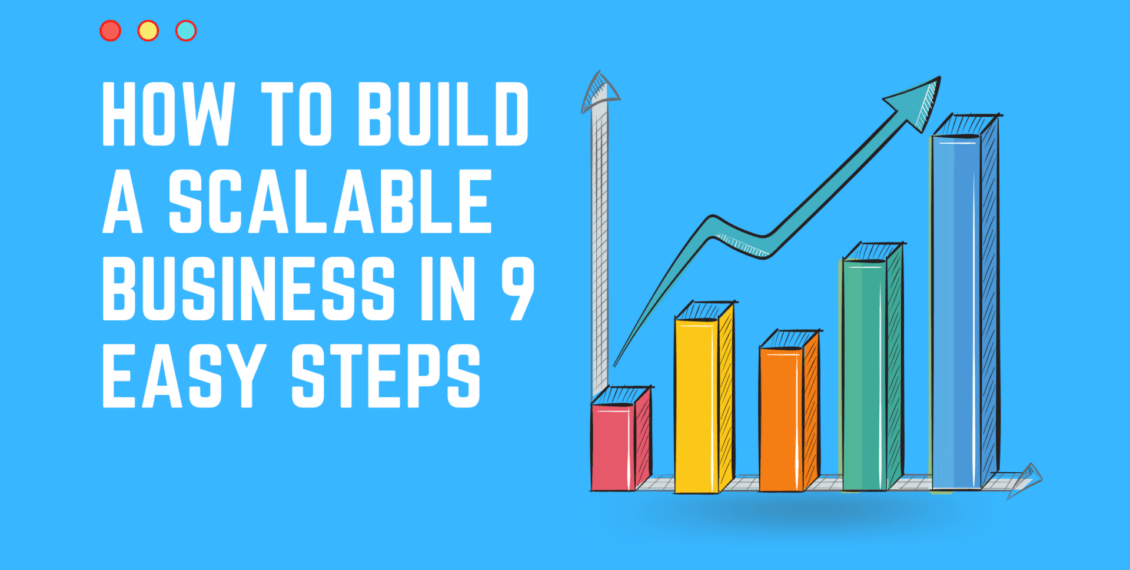More...
Many small and medium-sized businesses do one thing really well. This strategy is great for getting from zero to one. Or, from nothing to a profitable business.
There comes a time when nearly all businesses get stuck. Usually somewhere in the 6 or 7-figure range.
Does this sound like you? Is your business stuck?
But, what if I told you there was a way to break past the bottlenecks in your business and transform your business into a scalable company? To get from 6 or 7-figure revenue business to 8, or even 9-figure businesses?
The answer often lies in the business model they adopt - transaction-based or scalable.
Keep reading, and I'll show you how.
Transaction-Based vs. Scalable Businesses
Finite, or Transaction Based business models rely on single transactions, which makes scaling much more difficult. You are always chasing the next customer or sale.
Scalable business models provide the opportunity for exponential growth.
Here, we'll explain the difference between the two.

What is a Finite or Transaction-Based Businesses?
A finite or transaction-based business is one that primarily relies on single, standalone transactions for revenue.
These businesses often sell products or services that are one-off in nature and do not necessarily encourage repeat business.
Their growth is often linear, meaning the resources and effort required to generate revenue increase proportionately with the business's growth.

To increase revenue, they need to increase the number of customers or the frequency of transactions, both of which can be costly and challenging.
Examples of transaction-based businesses could include a car dealership, a real estate agency, or a clothing boutique. While they can and do have repeat customers, each sale is essentially a separate, finite transaction.
Here's what characterizes them:
- Limited Scalability: These businesses often operate on a one-off or transactional basis with their customers. Each transaction is isolated and doesn't necessarily lead to a repeat purchase.
- Customer Acquisition Focus: They primarily focus on acquiring new customers to generate more sales, which can be costly and time-consuming.
- Lower Customer Retention: Due to the transactional nature, these businesses might struggle with customer retention and loyalty.
- Revenue Fluctuation: Their revenues can be unstable and unpredictable, as they depend on constantly finding new customers.
What is a Scalable Business?
On the other hand, a scalable business can increase revenue exponentially without a proportional increase in resources or effort.
This is often achieved by creating repeatable sales models and leveraging technology for automation.
Scalable businesses focus on strategies that increase the lifetime value of a customer, such as subscriptions, memberships, or repeat services.

Examples of scalable businesses include software as a service (SaaS) companies, subscription box services, and e-commerce platforms.
They aim to not only acquire customers but also retain them over a long period, maximizing the revenue they generate from each customer.
Here's what characterizes them:
- High Scalability: These businesses have structures and processes in place that allow them to expand their customer base and increase sales without a proportional increase in their costs.
- Customer Lifetime Value Focus: They focus on nurturing long-term customer relationships, leading to repeat business, and thus, a higher customer lifetime value.
- Stable Revenue Streams: They often have more predictable and stable revenue streams, as they can rely on repeat business from loyal customers.
- Innovation and Adaptability: These businesses are generally more innovative and adaptable, constantly finding ways to serve their customers better and stay ahead in the market.
- Maximize AOV and LTV: Scalable businesses emphasize increasing both Average Order Value and Lifetime Value of their clients, leading to more sustainable growth and profitability.
It's important to note that both types of businesses can be successful, but they require different strategies and mindsets.
The goal for many transaction-based businesses is to transition into being more scalable over time, which requires strategic planning, investment, and a focus on building long-term customer relationships.
Significant Differences in Scalable Businesses vs. Finite (Transactional) Businesses
Several vital differences separate six-figure businesses from those generating eight or ten figures in revenue:
How to Transition from Transaction-Based to Scalable
To grow from a transaction-based business to a scalable one requires a strategic shift in business practices, mindset, and often, the business model itself.
Here you will learn some techniques to transform your business into a more scalable one,

Focus on Repeat Business
Encourage repeat business by developing a diverse range of complementary products or services that cater to the different needs of your customers.
Implement a subscription model if applicable, as it provides a consistent revenue stream and creates a long-term relationship with the customer.
Consider creating a loyalty program that rewards customers for their repeat business.
This not only increases customer retention but also incentivizes larger orders and more frequent purchases.
An example:
Starbucks Builds Repeat Business
Starbucks is known for its quality coffee, but the real magic of their growth strategy lies in their ability to convert first-time customers into loyal, repeat customers.
When Howard Schultz first took over Starbucks in the 1980s, the company was primarily selling coffee beans, not brewed coffee. Schultz recognized the potential for a different kind of coffee experience that was about more than just the product. He transformed Starbucks into a "third place" between home and work—a place where people could relax, enjoy a good cup of coffee, and feel a sense of community.
Starbucks built its business model around repeat business from the beginning. They invested heavily in customer experience, from the comfortable seating and ambient music in their stores to the friendly baristas who strive to know your order by heart. Starbucks created a rewards program that incentivized repeat purchases by offering free drinks and discounts to frequent customers. They also pioneered mobile ordering and payment, making it even more convenient for customers to choose Starbucks for their daily coffee.
This focus on cultivating repeat business has paid off handsomely. Starbucks has grown from a single store in Seattle to a global brand with over 30,000 locations worldwide. Their customer retention strategies have created a base of loyal customers who visit Starbucks not just for the coffee, but for the experience.
Moreover, Starbucks' success with repeat business has allowed them to weather economic downturns and changes in consumer behavior better than many of their competitors. Despite the rise of at-home brewing and competition from cheaper alternatives, Starbucks has maintained a strong and steady growth trajectory, largely due to its focus on customer loyalty and repeat business.
Maximize Customer Lifetime Value (CLV)
Prioritize building long-term customer relationships over making quick sales.
This involves providing excellent customer service, regularly engaging with your customers, and offering personalized solutions.
Use data analytics to understand your customers' behavior and preferences, and tailor your marketing strategies accordingly.
By improving customer satisfaction and retention, you increase the total revenue generated from each customer over the duration of their relationship with your business.
An example:
Amazon Strategically Increases Customer Lifetime Value
Amazon is a prime example of a company that has effectively utilized Customer Lifetime Value (CLV) to drive its growth and scale.
From its start as an online bookstore, Amazon has continuously focused on increasing the lifetime value of its customers. The concept of CLV has been central to Amazon's strategy, guiding decisions about customer acquisition, retention, and expansion.
One of Amazon's most powerful tools in increasing CLV is its Amazon Prime membership. Introduced in 2005, Prime offers customers free two-day shipping for an annual fee. Over time, Amazon has added more benefits to Prime, such as streaming video and music, exclusive deals, and more. These benefits encourage customers to make more purchases and stay loyal to Amazon, thus increasing their CLV.
Amazon doesn't just stop at selling products. They offer services like Amazon Web Services, Kindle, and Alexa, which further increase the touchpoints with customers, thereby increasing the CLV. They have even entered the grocery market with Amazon Fresh and the acquisition of Whole Foods. This extensive ecosystem of products and services encourages customers to spend more and more with Amazon over time.
Moreover, Amazon's obsession with customer service also plays a crucial role in its CLV strategy. From easy returns and exchanges to reliable delivery, Amazon goes out of its way to keep customers happy, knowing that a satisfied customer is more likely to be a repeat customer.
Amazon's ability to continuously increase the CLV of its customers has been a critical factor in its transformation from an online bookstore to a trillion-dollar company. Through Prime memberships, diversified offerings, and excellent customer service, Amazon maximizes the CLV, leading to sustained growth and profitability.
Increase Average Order Value (AOV)
Upselling and cross-selling are effective strategies to increase the value of each transaction.
Upselling involves encouraging customers to buy a higher-end product or service than the one they're considering, while cross-selling involves promoting complementary products.
You can also offer bundle deals or volume discounts to incentivize larger purchases.
Implementing these strategies not only boosts your revenue but also enhances customer satisfaction by helping customers get more value from their purchase.
An example:
McDonald's Famous AOV Booster
In the early 2000s, McDonald's faced a challenging period due to increased competition and changing consumer tastes. However, the company successfully turned things around with a strategy that included a strong emphasis on increasing AOV.
One of the key initiatives in this strategy was the introduction of the "Would you like to supersize that?" upsell. By simply asking this question, McDonald's encouraged customers to upgrade their meal to a larger size for a small additional cost. This approach proved highly successful, as many customers opted for the upsell, leading to a significant increase in AOV.
Another successful strategy was the introduction of the Dollar Menu, which, counter-intuitively, led to an increase in AOV. While the individual items on the menu were priced at just a dollar, the low price enticed customers to buy multiple items, often adding them to a regular meal, thus increasing the overall value of their order.
McDonald's also diversified its menu by introducing premium items, like the Angus Third Pounder and the McCafe line of coffee beverages. These items, priced higher than the traditional offerings, attracted a different segment of customers willing to spend more, thus increasing the AOV.
Recently, McDonald's has also utilized technology to increase AOV. They've introduced self-service kiosks and a mobile app, both of which have been found to increase order values, as customers are more likely to add extras when ordering digitally.
Through these strategies, McDonald's was able to increase its AOV, which played a significant role in the company's turnaround and growth. This case highlights the impact that increasing AOV can have on a business's scalability and profitability.
Automate and Systematize
Scaling a business requires efficient operations that can handle increased workload without a proportional increase in resources or effort.
Identify repetitive tasks in your operations and automate them using technology.
This could include tasks like invoicing, customer follow-ups, order fulfillment, and social media posting.
Also, create standard operating procedures (SOPs) for all key processes in your business. SOPs ensure consistency in performance, reduce errors, and make it easier to onboard new team members as your business grows.
Two Maids & a Mop Utilizes SOP's to Build a Scalable Franchise
Founded by Ron Holt in 2003 with just $150,000, Two Maids & A Mop started as a small cleaning service in Pensacola, Florida. The key challenge was to ensure consistency and high-quality service across different homes, which required robust systems and processes.
Recognizing this need, Holt developed a unique "Pay for Performance" plan, which determined employee wages based on customer ratings. This system not only ensured a high-quality cleaning service but also motivated employees to consistently perform at their best.
In addition, Holt established clear SOPs for every cleaning task. This included detailed checklists for cleaning different areas of a house, right down to the number of strokes needed to clean a mirror. Every new hire was trained in these procedures to ensure a consistent customer experience.
Holt also embraced technology, implementing a proprietary software system that managed scheduling, customer feedback, and other critical operational tasks. This allowed the company to handle a high volume of cleaning jobs efficiently and effectively.
In 2013, Holt decided to franchise the business. The clear systems, processes, and SOPs he had developed made it easy for franchisees to replicate the business model. Today, Two Maids & A Mop has over 70 franchises across the U.S. and continues to grow.
This case study illustrates how a service company can scale successfully by implementing robust systems, processes, and SOPs.
Leverage Technology
Digital technology can significantly enhance your business's scalability. Use e-commerce platforms to sell your products or services online and reach a larger audience.
Utilize customer relationship management (CRM) software to manage your customer interactions more effectively and gain insights into your customer base.
Use digital marketing tools to promote your business and attract more customers.
By leveraging technology, you can automate processes, improve efficiency, and scale your operations.
Example:
Domino's Dominates with Their Tech Stack
In the early 2010s, Domino's was struggling with a reputation for poor-quality food. However, they managed to turn their fortunes around, largely through an innovative approach to technology.
Domino's invested heavily in its digital infrastructure, creating a seamless online ordering system that made it easy for customers to customize their orders, track their delivery in real-time, and even save their favorite orders for future convenience. They introduced their "Domino's AnyWare" campaign, allowing customers to order pizza from a multitude of devices and platforms, including smart TVs, smartwatches, and social media platforms.
In 2015, Domino's went a step further and introduced a voice-activated virtual assistant, Dom, for its mobile app, which uses artificial intelligence to interact with customers and take their orders. They also integrated with Amazon's Echo, enabling customers to order pizza simply by asking Alexa.
On the operational side, Domino's implemented GPS tracking for their delivery drivers, improving delivery efficiency and accuracy. They also used data analysis tools to analyze sales trends, customer preferences, and operational efficiencies at a granular level, using these insights to make data-driven decisions and improvements.
The use of these technologies resulted in Domino's online sales skyrocketing, with over 60% of their US sales coming from digital channels as of 2018. This digital transformation helped Domino's to overtake Pizza Hut as the top pizza chain in terms of global sales in 2018.
This case study shows how a strategic investment in technology can revolutionize a company's operations, drastically improve customer experience, and allow a business to scale rapidly. Domino's transition from a struggling pizza chain to a technology-driven, industry-leading powerhouse is an excellent example of how technology can be leveraged for business scalability.
Build a Strong Team
As your business grows, you'll need a capable team that can handle different aspects of the business.
Identify the skills and expertise you need in your team and hire accordingly.
Invest in training and development to enhance your team's skills and keep them updated with industry trends.
A motivated and skilled team not only helps you manage your growing operations but also brings in fresh ideas and perspectives that can drive your business growth.
Moz Goes from Link Building to Team Building
Let's take a look at the case of Moz, a software as a service (SaaS) company that sells inbound marketing and marketing analytics software subscriptions.
Moz was founded by Rand Fishkin and his mother, Gillian Muessig, in 2004. Initially, the company was a struggling consulting service named SEOMoz. The organization was facing severe cash flow problems and was nearly bankrupt.
In 2007, Fishkin decided to pivot the business from consulting to software. The company had developed several SEO tools for internal use, and they decided to package those tools and sell subscriptions.
To make this transition, Fishkin needed a dedicated and skilled team. He focused on hiring passionate people who were not only experts in their field but also aligned with Moz's vision and culture. He was famously transparent with his team, sharing key details about the company's financials, strategy, and challenges.
Fishkin also invested heavily in employee development, believing that a highly skilled and motivated team was key to the company's success. He created a positive work environment, offering perks like paid time off for learning, transparent promotion paths, and a 'TAGFEE' (Transparent, Authentic, Generous, Fun, Empathetic, Exceptional) code of conduct.
This strong team was pivotal in Moz's transition from a consultancy to a successful SaaS company. They developed and improved the software, provided excellent customer service, and created a wealth of SEO resources that helped establish Moz as a thought leader in the industry.
By 2013, Moz was generating $29.3 million in annual revenue, a significant increase from their $1.1 million in 2007. Moz's journey is a testament to the power of building a strong, aligned, and motivated team when scaling a business. It's a great example of how a small business can achieve impressive growth through people.
Financial Management
Understanding your financials is crucial for scaling your business.
Monitor your cash flow closely and ensure you have enough funds to support your growth plans.
Understand your profit margins and look for ways to reduce costs without compromising on quality.
Regularly review key financial metrics like gross margin, net profit margin, operating margin, and return on investment (ROI).
These insights will help you make informed decisions about pricing, cost management, investments, and other aspects of business growth.
Example:
Zappos Turnaround through Financial Engineering
Let's consider the case of Zappos, the online shoe and clothing retailer, as an example of scaling through improved financial management.
Zappos was founded by Nick Swinmurn in 1999, and it struggled initially with financial stability. The company was losing money on every sale due to free shipping, a generous returns policy, and the cost of maintaining a vast inventory. This model was unsustainable, and the company was on the verge of bankruptcy.
Enter Tony Hsieh, who initially invested in Zappos and then came on board as CEO. Hsieh recognized the financial challenges and set about making necessary changes.
First, he focused on operational efficiencies and renegotiated terms with suppliers. Instead of holding inventory, they would place the customer's order with the supplier, who would then ship the product directly. This drop-shipping model dramatically reduced inventory costs and improved cash flow.
Secondly, Hsieh focused on customer service as a differentiating factor, investing in a 24/7 call center and training staff to provide outstanding service. This resulted in higher customer loyalty and repeat purchases, increasing the lifetime value of each customer and further improving the financial health of the business.
Under Hsieh's leadership, Zappos turned its finances around. By 2009, the company hit $1 billion in annual sales, and it was acquired by Amazon in a deal valued at $1.2 billion. This story showcases the power of savvy financial management in scaling a business. Zappos transformed from a company hemorrhaging cash into a profitable and sustainable enterprise.
Continuous Improvement
The market and customer preferences are constantly changing.
To keep up, you need to continuously improve your products, services, and processes.
Use customer feedback and market research to identify areas for improvement.
Implement a culture of innovation in your business where new ideas are encouraged and tested.
Regularly review your business strategies and make necessary adjustments.
Remember, what worked for your business at one stage may not work at another stage. Being adaptable and responsive to change is key to scaling a business.
Example:
The Famous Toyota Story
Toyota, the Japanese multinational automotive manufacturer, is famous for its Toyota Production System (TPS), which is based on the concept of "Kaizen" or continuous improvement. The company's commitment to continuous improvement has made it one of the largest and most successful car manufacturers in the world.
Toyota's journey began in the late 1940s when the company was struggling to compete with its more established Western counterparts. To overcome this challenge, they developed the TPS, which focused on eliminating waste, improving quality, and reducing production costs.
One of the key aspects of the TPS is the idea that everyone in the organization, from the CEO to the factory floor worker, is responsible for identifying areas for improvement. This culture of continuous improvement led to numerous innovations in manufacturing, such as the "just-in-time" production system, which reduced inventory costs and improved efficiency.
Another aspect of Toyota's continuous improvement approach is the concept of "genchi genbutsu," or "go and see for yourself." This encouraged managers to go to the factory floor to observe processes and identify problems firsthand, leading to more effective problem-solving and improvement.
Toyota's commitment to continuous improvement helped the company scale dramatically. Today, Toyota is a global leader in the automotive industry, selling millions of vehicles each year, and it's often held up as a model of efficient and quality-focused manufacturing.
This example underscores the power of a culture of continuous improvement in scaling a business. By constantly seeking ways to improve processes, reduce waste, and increase efficiency, Toyota was able to grow from a small, struggling company to a global powerhouse.
Upsizing Your Market
For a scalable business, thinking about market size involves envisioning a landscape of expansive opportunities. The beauty of a scalable business lies in its potential for exponential growth without the need for a proportional increase in resources. In this scenario, a larger market inherently provides more opportunities for growth and scale.
Moreover, market saturation becomes less of a concern in vast markets. This ensures that a scalable business can continue to grow, acquiring new customers over an extended period. This diverse customer base also mitigates risk, providing stability as the company isn't overly dependent on a small group of consumers.
Scalable businesses with large target markets also have a magnetic pull for investors, becoming a key factor in their decision-making process due to the direct impact on potential returns on their investment.
Lastly, a larger market often presents a plethora of customer needs and preferences. This diversity becomes the bedrock for driving innovation and adaptation, enabling the business to evolve and maintain competitiveness.
But what if you started off with a small target market? Can you expand?
Absolutely! You can add more locations, you can expand your product line, you can add more services.
How about an example:
Allbirds Upsizes Their Market for Continuous Scalability
Allbirds started in 2016 as a niche company selling sustainable woolen sneakers. The initial TAM was relatively small - environmentally conscious consumers who were interested in sustainable footwear. However, the company quickly garnered a cult-like following due to its commitment to creating comfortable, sustainable footwear.
Recognizing the opportunity to expand, Allbirds started to diversify its product line. It launched new styles of shoes, introduced new sustainable materials (like eucalyptus tree fiber and sugarcane), and eventually moved into apparel. They expanded into socks, underwear, and most recently into activewear, directly challenging established brands like Lululemon and Nike.
With each new product category, Allbirds increased its TAM, reaching customers who might not have been in the market for sustainable woolen sneakers but were interested in other sustainable apparel. The company's commitment to sustainability and comfortable design kept their original fan base loyal while attracting a broader range of consumers.
This expansion has paid off. As of 2021, Allbirds was valued at $1.7 billion, and it's still growing, showing that a commitment to a core mission coupled with strategic expansion can pay dividends even for smaller businesses
Conclusion
Transitioning from a transaction-based to a scalable business model doesn't happen overnight. It's a process that requires strategic planning, investment, and a lot of hard work.
But with the right approach, it's a very achievable goal.
Embrace the journey, and before you know it, you'll be on your way to scaling the heights of business success.

